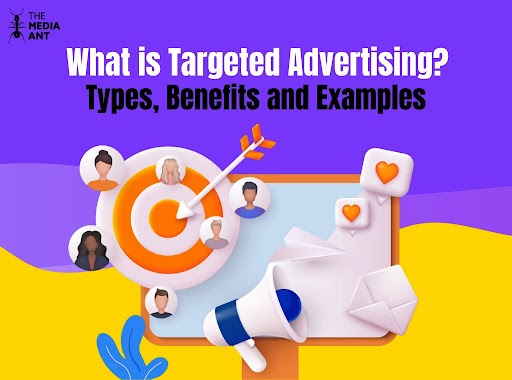In this omnipresent digital world, there is a potent tool as the fine-tuned surgeon’s scalpel and as convincing like the blockbuster’s captivating plot. This is the world of “Targeted Advertising,” where factors such as data, technology and also creativity can be transformed into a symphony that targets an audience at just the right moment. This is not simply a list of tricks, it’s an exploration into the core center of modern advertising, where every click tells a story and every impression has transformational potential.
What is Targeted Advertising?
Ad targeting or targeted advertising is a technique of marketing where ads are tailor-made and displayed to consumers based on their individual characteristics, attributes as well reactions determined from behavioral patterns over time. This method is also more personal rather than traditional advertising methods which are impersonal and generalized.
- The first step is to collect data from users’ activities or websites they visit, purchased goods or objects posted about on social networks.
- After the required amount of data has been acquired, advertisers build comprehensive customer profiles accordingly. These profiles segregate people on different bases like demographics, online behavioral patterns, interests and preferences.
- Through these profiles, advertisers create professional messages targeting each segmented group.
- Complex algorithms are used to determine the time and location of these ads. The choice is based on the rhythm between an individual’s profile and criteria established by advertisers.
- When the ads are displayed, subsequently there is retrieval of more information on how customers interact with them (for instance clicks views and buys). This provides valuable feedback that can be used to further improve user profiles and make future ad targeting more specific.
By ensuring that a particular ad content will be delivered to those people who are most likely interested in the product or service being promoted, targeted advertising is efficient with its work. This makes advertising more effective and economical because the response probability is elevated. This type of advertising is also aimed at customizing the appeal to suit a specific target audience with particular needs and interests. Targeted ads are effective in improving user experience, boosting loyalty toward brands as well as sales objective for driving revenue growth.
Types of Targeted Advertising

Understanding these types can help businesses design more effective and personalized marketing campaigns. Here’s a detailed look at each type:
1. Contextual Targeting
This form refers to the ads placement on webpages that are related with message of the ad. For instance, a running shoes’ advertisement may be seen on sites with sport news or blogs dedicated to sports fitness. The trick lies in customizing the creative to suit the surrounding content of where it is placed or shown, thus making the whole process homogeneous and contextual.
2. Behavioral Targeting
It works by tracking user behavior on the internet wherein certain past behaviors such as previously visited websites, related searches performed and products purchased are patterned to present them with ads that suit their interests. It’s built upon the assumption that present behaviors could tell us how future interests and needs are going to be. For instance, a user who often looks up cooking sites may notice more ads featuring kitchen appliances or fox high-end food items.
3. Geotargeting
Geo targeting targets ads to users who are in the geographical locations. It is especially effective for local businesses or events that are intended to appeal primarily. For instance, a restaurant located in the region can use geo targeting so that only those users who are within 5 miles from it will see their ads.
4. Social Media Targeting
Due to the large and highly detailed demographic, interest, and behavior data available on social media platforms with such a huge user base, advertisers are able to direct their adverts at an individual consumer’s profile. This technique can be very effective as it enables access to specific information, such as likes, follows and comments particular for certain content.
5. Retargeting
This type of advertising is also referred to as remarketing and appeals mainly towards previous users that have had interactions with a brand or visited its site. It is an opportunity to revive lapsed prospects who were interested but did not transact. The retargeting, for instance, can be utilized after a user has placed the product into their cart but then abandoned it. Retargeting will display ads of that particular product in hopes to remind them or offer some type of discount towards making a purchase.
Targeted Advertising Strategies

For focused advertising, the focus is mainly on using the consumer information to create and display advertisements that match certain needs of consumers as well as their behaviors.
1. Segmentation
Segmentation, an important tool for targeted marketing, is the breakdown of audiences into criteria such as demographics (age, gender and income level), geographic location data and also psychographic social class values interests.What makes segmentation so very effective is the fact that it enables targeting ads based on these narrow audience segments.
2. Email and SMS Marketing
Email and SMS marketing begin with the list segmentation. For instance, in e-commerce knowing which product types, colors or sizes do your customers search for can help in building targeted messages creating more successful leads.
3. Social Media Marketing
Social networking sites like facebook, instagram, linkedin etc have a rich user data that is very valuable for the targeted advertising. However, the strategies are very different for each platform and also target demographics, interests, job titles et cetera. For instance, LinkedIn is very beneficial for B2B firms because it has a professional user base.
4. Content Marketing
This includes developing relevant content which focuses on the interests, pain points and also challenges of an identified buyer persona. It can be a passive form of the content like blogging or an active one that involves sending white papers through account-based marketing.
5. Google Ads and PPC
Pay-Per-Click advertisement is largely built on the segmentation and targeting to place ads with the help of extensive information regarding the users through Google Ads.
Benefits of Targeted Advertising
Targeted advertising, which involves directing promotional messages to specific audiences based on various criteria such as demographics, interests, and online behavior, offers several advantages for businesses and consumers alike. Here are five key benefits:
1. Increased Relevance for Consumers
Targeted advertising ensures that the ads consumers see are more relevant to their interests and needs. This increases the likelihood that they will engage with the advertisement, leading to a better user experience and potentially higher satisfaction with the advertised products or services.
2. Higher Conversion Rates
Because targeted ads are directed at individuals who are more likely to be interested in the product or service, the chances of converting these viewers into customers are significantly higher. This leads to more efficient use of advertising budgets and better return on investment (ROI).
3. Cost-Effective Advertising
By focusing on a specific audience, businesses can avoid the waste associated with traditional mass marketing campaigns that reach a broad, uninterested audience. This targeted approach reduces ad spend and increases the efficiency of marketing efforts.
4. Improved Campaign Performance Metrics
With targeted advertising, businesses can more easily track and analyze the performance of their campaigns. Metrics such as click-through rates (CTR), conversion rates, and customer acquisition costs can be monitored more accurately, allowing for data-driven adjustments and optimization of future campaigns.
5. Personalized Customer Experience
Targeted advertising allows for personalization, which can enhance the customer experience. Personalized ads that address the specific preferences and behaviors of consumers can foster a stronger connection between the brand and the customer, leading to increased loyalty and repeat business.
Targeted Advertising Examples
1. Paper Boat’s #FloatABoat Campaign
This campaign tapped into nostalgia, asking people to make paper boats and share them on social media. For each shared post, Paper Boat promised to donate to children’s education, effectively combining marketing with social responsibility.
2. Make My Trip’s Hashtag Campaign #DilHaiHindustani
On the occasion of India’s Independence Day, Make My Trip capitalized on it to run a social media campaign where moments that marked history in India’s fight for independence were highlighted. This program was directed to the younger generation and really used an emotional link provided by a nation’s past.
3. Amazon India’s The Great Indian Freedom Sale
On the occasion of Independence Day, Amazon India ran a digital marketing campaign with very special discounts. Taking this opportunity, they arranged a contest called #10KeBaadKarenge wherein the customers were encouraged to defer their shopping plans until the postponement of Amazon’s sale gained more consumer engagement and also sales.
4. KFC India’s Social Media Campaigns
In a bid to harness its presence online and increase brand awareness, KFC India introduced many social media campaigns such as ‘Design your own bucket’, ‘Radio KFC RJ Hunt, and’ Currycature’. These campaigns particularly empowered the youth and also increased social media activity.
FAQs on Targeted Advertising
What is an example of target advertising?
One of the targeted advertisements is, for instance, when a fitness apparel company places ads concerning running shoes on a health and fitness blog in order to get it from the people who are interested in this topic.
Why is targeted advertising good?
The success of targeted advertising is based on the fact that it directs its message toward an audience ready to pursue interest in a product, with higher engagement rates and also conversions as well as ROIs for businesses.
Does targeted advertising work?
Indeed, targeted advertising has proven to be very effective through the delivery of relevant ads to a particular audience whose engagement and also conversion rate are highly enhanced while their return on investment increases for marketers.
Do people like targeted ads?
Opinions are not the same among people, some find targeted ads very important and tailored to their personal interests while others consider them annoying or too persistent.





